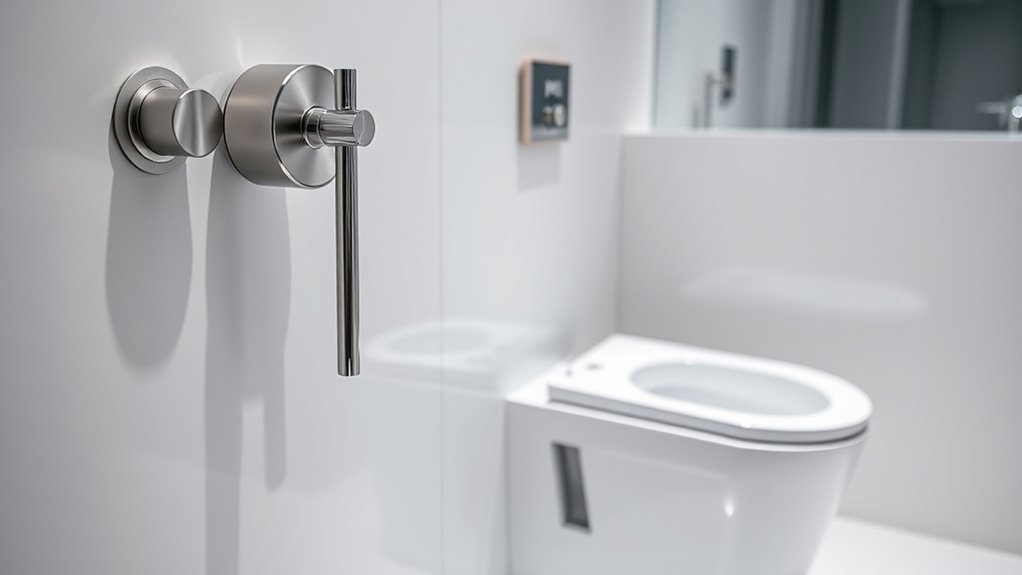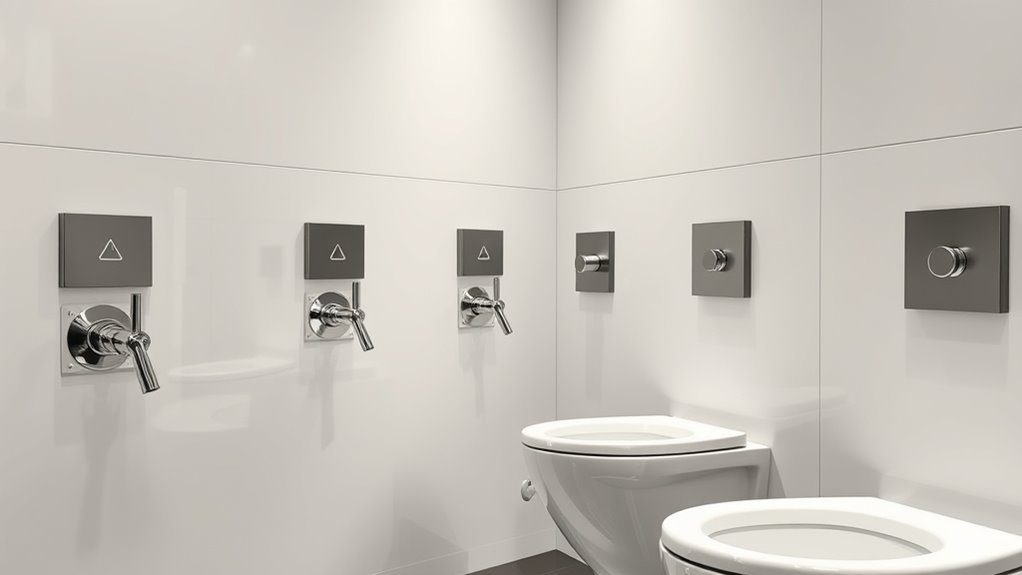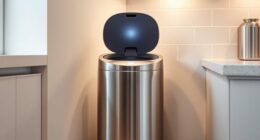Tankless toilets with flushometer systems are great for conserving water and saving space, thanks to their instant, pressurized flushing. However, they require regular maintenance to prevent mineral buildup and leaks, which can be more complex than traditional toilets. If properly maintained, they provide a sleek, efficient solution, but their reliance on a steady water supply and specialized parts can be drawbacks. Keep exploring to discover how to keep these systems running smoothly.
Key Takeaways
- They save water by delivering only the necessary amount with pressurized, instant flushes, ideal for eco-conscious spaces.
- Their sleek, tankless design offers a modern appearance and space-saving benefits in various environments.
- Regular maintenance is essential to prevent mineral buildup and ensure system components like the flushometer valve function properly.
- They can be more complex and costly to repair due to specialized parts and the need for technical expertise.
- Dependence on a reliable water supply means system performance may be affected by supply disruptions or issues.

Have you ever wondered if there’s a more efficient way to handle your bathroom needs? If you’re looking for a solution that minimizes water usage while eliminating traditional tank storage, tankless toilets, specifically those using flushometer systems, might catch your interest. These systems are designed to deliver a powerful, instant flush without the need for a tank, which can considerably impact water efficiency. Instead of filling a tank before each flush, these toilets rely on a pressurized water supply that activates immediately when you push the handle or sensor. This design helps conserve water because it delivers only what’s necessary, reducing waste compared to conventional toilets that often use more water to refill the tank after each flush. If you’re conscious about water conservation, this feature alone can make tankless toilets a compelling choice.
However, while water efficiency is a notable advantage, you should also consider the maintenance challenges associated with these systems. Because they operate on a pressurized water supply, they require regular inspection to ensure the flushometer valve and other moving parts function correctly. Over time, mineral buildup or debris can cause leaks or reduce the flush performance, leading to potential repairs. Unlike traditional tank systems, which are relatively simple to troubleshoot and fix, flushometer-based systems often demand specialized knowledge for maintenance. This can increase the cost and effort required to keep the toilet functioning effectively over its lifespan. Additionally, the absence of a tank means there’s no water reserve within the unit itself, so if the water supply line experiences issues, the entire system could become inoperable until repairs are made.
Despite these maintenance challenges, many facilities opt for tankless toilets because they’re space-saving and reduce the likelihood of tank-related problems like leaks or overflows. The sleek, modern design appeals to commercial spaces, public restrooms, and eco-conscious homes looking to cut down on water bills and environmental impact. Still, it’s essential to weigh these benefits against potential upkeep costs. Proper installation and regular maintenance are vital to ensuring the system continues to operate efficiently and reliably. Advances in AI-driven solutions are also beginning to influence how these systems are monitored and maintained, potentially reducing ongoing costs and improving performance. Overall, if you’re willing to invest in proper upkeep and desire a modern, water-efficient solution, tankless toilets with flushometer systems can be a smart, sustainable choice. Just be prepared for the maintenance demands that come with their innovative design.
Frequently Asked Questions
How Long Do Tankless Toilet Components Typically Last?
You might wonder how long tankless toilet components last. Typically, their component durability can range from 10 to 15 years, depending on usage and maintenance. Replacement intervals vary but usually occur around this time frame, especially if you notice leaks or operational issues. Regular upkeep can extend their lifespan, ensuring reliable performance. Keep an eye on signs of wear to avoid unexpected repairs and maintain ideal functionality over the years.
Are Tankless Toilets Suitable for High-Traffic Commercial Buildings?
Imagine managing a busy airport restroom, where durability and space efficiency are essential. Tankless toilets excel in high-traffic commercial buildings because they offer commercial durability and save space. Their robust flushometer systems handle frequent use without breaking down, making them reliable. You’ll appreciate how their compact design frees up room, enhancing user experience and maintenance. For high-traffic settings, tankless toilets are a smart, efficient choice that keeps facilities running smoothly.
What Maintenance Is Required for Flushometer Systems?
You’ll want to regularly inspect your flushometer system to guarantee it functions properly. Clean the sensors and flush valves to prevent buildup, which can affect water conservation efforts. Check for leaks and tighten fittings to prevent vandalism or misuse. Replacing worn parts promptly keeps the system efficient and helps conserve water. Routine maintenance not only prolongs the system’s lifespan but also supports vandalism prevention and sustainable water use.
How Do Tankless Toilets Perform During Power Outages?
During a power outage, your tankless toilet is like a ship without a sail—unable to operate normally. These systems often lack power outage resilience, so they won’t flush without electricity. To guarantee functionality, consider installing emergency backup systems like battery-powered controls. This way, you keep your toilet running smoothly when the grid goes dark, maintaining hygiene and convenience even in the face of unexpected outages.
Can Tankless Toilets Be Installed in Existing Plumbing Setups?
You can install tankless toilets in existing plumbing setups, but you should verify plumbing compatibility first. These systems often require specific water pressure and flow rates, which might pose installation challenges if your current plumbing doesn’t meet those standards. Consulting a professional plumber helps ensure a smooth installation, addressing any compatibility issues and avoiding potential problems later. With proper evaluation, upgrading to a tankless toilet is definitely doable.
Conclusion
Tankless toilets, or flushometer systems, offer quick, efficient flushing and save space, making them ideal for commercial settings. However, they can be costly to install and may require more maintenance. Notably, a recent study found that commercial buildings with tankless toilets use 20% less water annually compared to traditional models. Considering this, if you’re aiming to boost efficiency and conserve water, tankless toilets could be a smart choice—just weigh the initial costs against long-term savings.









